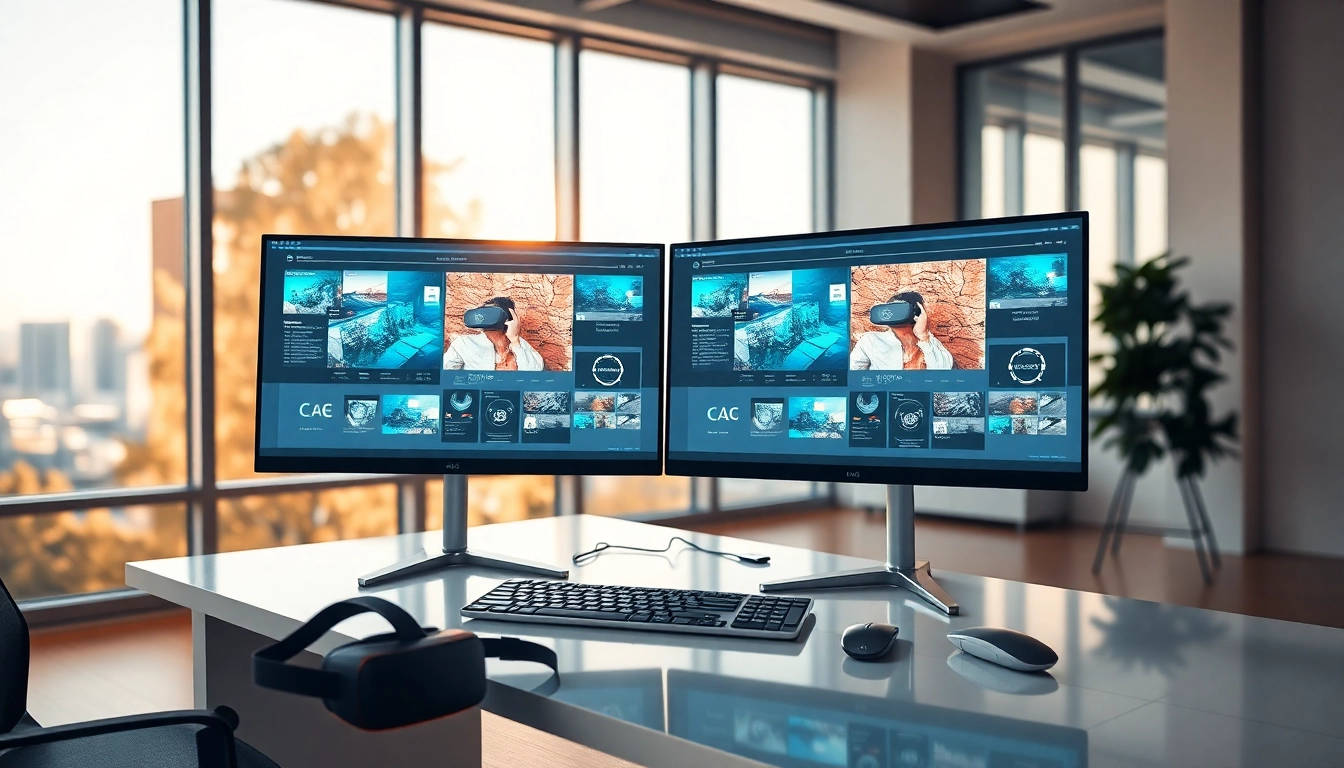Understanding Virtual Desktop: An Overview
What is a Virtual Desktop?
A virtual desktop is a tool that allows users to access a computer environment remotely. It simulates a desktop experience through a server, enabling users to interact with their operating system, applications, and files from anywhere with internet capabilities. This technology is part of the broader category of desktop virtualization, which encompasses various methods that allow multiple desktop environments to run on a single hardware platform. Users can access their systems through thin clients, laptops, tablets, and smartphones, which eliminates the need for high-performance hardware at local locations, making it a cost-effective solution for businesses and individuals alike.
Key Benefits of Using Virtual Desktop
- Accessibility: Users can reach their desktop environments from any device with internet access, promoting flexibility and remote work capabilities.
- Cost Efficiency: By utilizing data centers for processing power, businesses can reduce hardware costs and maintenance, investing resources into more strategic initiatives.
- Enhanced Security: Data resides on secure servers rather than local machines, reducing risks of data loss from device theft or damage. Security protocols can be centralized, simplifying compliance with regulatory standards.
- Improved Management: IT teams can easily deploy, update, and manage applications and security policies across all virtual desktops, increasing operational efficiency.
- Scalability: Virtual desktop solutions can grow with a company’s needs. As more users require access, resources can be allocated without upgrading physical infrastructure.
Common Use Cases of Virtual Desktop
Many sectors benefit from implementing virtual desktop solutions. Common use cases include:
- Healthcare: Medical professionals require immediate access to patient records and applications across various locations, ensuring timely and reliable care.
- Education: Institutions can furnish students with virtual environments to access software and resources, supporting remote and hybrid learning without the need for heavy local installations.
- Corporate Remote Work: Organizations employing remote or hybrid models can provide employees access to company resources securely from their homes.
- Software Development: Development teams can build and test applications in isolated virtual environments that mirror production systems.
- Government Agencies: Secure access to applications can allow government workers to maintain productivity from remote locations while safeguarding sensitive data.
Implementing Virtual Desktop Solutions
Choosing the Right Virtual Desktop Software
Selecting the appropriate software for a virtual desktop implementation is crucial, as it directly impacts performance, user experience, and security. Factors to consider include:
- Compatibility: Ensure the software is compatible with existing infrastructure and can easily integrate with other applications and services in use.
- Usability: The interface should be intuitive to minimize the learning curve for users, enhancing productivity.
- Support and Updates: Evaluate the provider’s support reliability and their commitment to regular updates, which are vital for security and functionality.
- Cost Structure: Analyze the pricing model—whether subscription-based, pay-per-use, or one-time licenses—to find a solution that fits financial constraints.
- Performance: Review benchmarks and user testimonials focusing on the speed and reliability of the virtual desktop experience under varying network conditions.
Hardware Requirements for Optimal Performance
The performance of a virtual desktop environment is significantly affected by the underlying hardware. Considerations include:
- Server Specifications: Powerful servers form the backbone of virtual desktop environments, necessitating high CPU capacity, ample RAM, and fast SSD storage to support multiple users simultaneously.
- Network Infrastructure: A robust network is critical, including bandwidth allocation to prevent latency issues. Quality of Service (QoS) configurations can prioritize virtual desktop traffic.
- Client Devices: While local hardware doesn’t need to be cutting-edge, devices must support the necessary connectivity protocols and display the virtual desktop effectively.
Setting Up Your Virtual Desktop Environment
Setting up a virtual desktop involves several steps:
- Infrastructure Setup: Arrange servers in a data center or choose cloud services based on the organization’s needs.
- Software Installation: Install the chosen virtual desktop software on the server.
- User Provisioning: Create user profiles, assign roles, and ensure each user has appropriate access to applications and resources.
- Testing: Conduct tests to evaluate performance, login times, and application access to ensure efficiency before rolling it out for broader use.
- Training: Provide documentation and training sessions to users to help them familiarize themselves with the new environment.
Enhancing User Experience with Virtual Desktop
Customizing Your Virtual Desktop Settings
Customization options in a virtual desktop improve user satisfaction and productivity. Potential adjustments include:
- User Interface Adjustments: Allow users to modify desktop backgrounds, themes, and icon arrangements to create a more personal workspace.
- Performance Settings: Let users optimize settings related to graphics performance and resource allocation according to their specific needs.
- Application Layouts: Users should be able to create customized layouts for frequently used applications to streamline their workflows.
Integrating Peripheral Devices with Virtual Desktop
The integration of peripheral devices, such as printers, scanners, and additional monitors, enhances the functionality of a virtual desktop. Key considerations include:
- Driver Support: Ensure the virtual desktop software supports required drivers for seamless integration with peripheral devices.
- Connectivity: Utilize both wired and wireless connections efficiently to ensure that peripheral devices work without issues.
- Multi-Monitor Support: Implement solutions that allow users to extend their virtual desktop across multiple monitors for enhanced multitasking capabilities.
Security Best Practices for Virtual Desktop Users
Security is crucial in managing a virtual desktop solution. Best practices include:
- Data Encryption: Utilize end-to-end encryption protocols to protect data during transmission.
- Access Controls: Implement strict access control policies to limit who can access sensitive information and applications.
- Regular Updates: Regularly update both the operating system and applications to patch vulnerabilities quickly.
- User Training: Conduct security awareness training sessions for users to help them recognize phishing attempts and other security threats.
Comparative Analysis of Virtual Desktop Options
Comparing Different Virtual Desktop Technologies
Different technologies exist within the virtual desktop ecosystem, each with its own characteristics:
- Traditional Virtual Desktop Infrastructure (VDI): Typically hosted on-premises, VDI provides a stable environment in private data centers which gives organizations full control, but may lack flexibility and scalability.
- Desktop-as-a-Service (DaaS): Cloud-based solutions enable users to access desktops remotely without maintaining the infrastructure, promoting flexibility but potentially incurring higher ongoing costs.
- Remote Desktop Services (RDS): A less resource-heavy approach than VDI, RDS shares a single desktop across multiple users, which can increase risk and complicate user experience.
Pros and Cons of Cloud-Based vs Local Virtual Desktop
Choosing between cloud-based and local solutions for virtual desktop environments can significantly affect strategic decisions:
- Cloud-Based:
- Pros: Easy scalability, reduced infrastructure costs, and offloading maintenance responsibilities to providers.
- Cons: Dependence on internet connectivity and potential long-term costs if usage spikes.
- Local:
- Pros: Greater control and security, with data potentially residing within organization-controlled environments.
- Cons: Higher upfront costs and significant resource commitments are necessary for setup and maintenance.
Cost Considerations for Business Implementation
Implementing a virtual desktop solution involves various cost considerations, including:
- Initial Setup Costs: This includes hardware purchases, software licenses, and installation costs.
- Operational Costs: Ongoing expenses related to maintenance, support, and training must be factored in.
- Long-term Costs: To avoid unexpected expenses, organizations should consider potential upgrades and expansions.
- Cost Control Measures: Utilize cloud solutions with tiered pricing to manage costs effectively based on usage levels.
Future Trends in Virtual Desktop Technology
Innovations on the Horizon for Virtual Desktop
The virtual desktop landscape is evolving with rapid technological advances. Innovations to watch include:
- AI Integration: The use of artificial intelligence could streamline operations by learning user habits and optimizing resource allocation dynamically.
- Enhanced UX/UI: Ongoing improvements in user experience designs will make virtual desktops more intuitive and enjoyable to use.
- Edge Computing: As edge computing becomes prevalent, virtual desktops may shift closer to user locations, reducing latency and improving speed.
Impact of AI and Machine Learning on Virtual Desktop
AI and machine learning hold transformative potential for virtual desktop technologies by:
- Personalized Experiences: AI applications can enable desktops to adapt configurations and recommend applications based on user preferences.
- Predictive Maintenance: Machine learning can forecast hardware issues and prompt timely maintenance to prevent unexpected downtime.
- Improved Security Measures: AI can assist in monitoring for unusual activities or threats, enhancing the overall security posture.
Preparing for the Future of Remote Work with Virtual Desktop
As remote work becomes an enduring aspect of workplaces, organizations must prepare strategically. Actions include:
- Investing in Scalable Solutions: Organizations must ensure their virtual desktop solutions can grow with their teams and adapt to changing work dynamics.
- Emphasizing User Support: Providing robust support and training resources for users can result in smoother transitions and higher productivity.
- Continuous Evaluation: Regular assessments of virtual desktop performance will provide insights and opportunities for improvement, shaping a competitive technology strategy.


